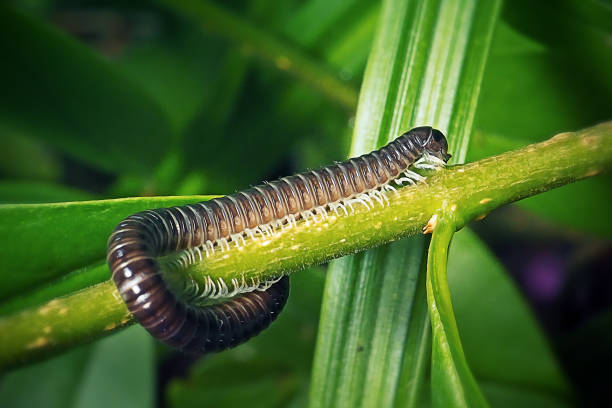All About Millipedes
Millipedes are elongated, multi-legged arthropods commonly found in damp environments. While they are not harmful to humans or pets, their presence in large numbers can become a nuisance, especially when they invade homes seeking shelter. Controlling millipedes is important to prevent them from entering living spaces and causing discomfort.
What are Millipedes?
Millipedes (class Diplopoda) are arthropods characterized by having two pairs of legs per body segment. Commonly known as “thousand-leggers,” their scientific name is derived from the Greek words “diplous” (double) and “podos” (foot). Millipedes are detritivores, primarily feeding on decaying organic matter.
Millipedes are slow-moving and usually curl into a spiral when disturbed. They thrive in moist environments and are most active at night. Despite their appearance, they play a crucial role in breaking down organic material, contributing to soil health.
How to Identify Millipedes
Appearance:
- Body Shape: Elongated, cylindrical bodies
- Size: Typically 2.5 to 4 cm in length
- Color: Generally brown or black
- Segments: Segmented bodies with two pairs of legs per segment
- Legs: Short legs that create a “wave-like” motion when they move
- Movement: Slow-moving, often curls into a spiral when disturbed.
Similar Pests:
Millipedes can be mistaken for centipedes, but centipedes have only one pair of legs per body segment, are generally faster, and are carnivorous.
Activity and Seasonality
Active Seasons: Millipedes are most active during the spring and fall, especially after heavy rains when they leave their outdoor habitats in search of drier conditions.
Lifecycle: Millipedes undergo incomplete metamorphosis, starting as eggs that hatch into small, legless nymphs. As they molt, they develop more body segments and legs. The lifecycle duration varies, but they can live for several years.
Where to Find Millipedes in or Around Your House
Common Habitats: Millipedes are commonly found in moist, dark environments such as under rocks, logs, leaf litter, and mulch. Indoors, they are often found in basements, crawl spaces, and bathrooms where humidity levels are high.
Specific Hiding Spots: Millipedes hide in cracks in foundation walls, under floorboards, and near leaky pipes or other moisture-prone areas. Outdoors, they may be found under piles of leaves, stones, or decaying wood.
How to Get Rid of Millipedes
- Immediate Action: When millipedes are spotted indoors, use a vacuum cleaner to remove them. Seal entry points around windows, doors, and foundation cracks to prevent further invasion.
- Professional Treatments: Professional pest control services can apply perimeter treatments around the home to create a barrier that keeps millipedes out. Moisture control treatments may also be recommended to reduce indoor humidity levels.
- DIY Methods: Homeowners can reduce millipede populations by eliminating moisture sources, such as fixing leaky pipes and using dehumidifiers. Sealing entry points and removing outdoor debris where millipedes hide can also help prevent them from entering the home.
How to Prevent Millipedes
- Seal Entry Points: Close gaps around doors, windows, walls, and utility lines, especially in basements and crawlspaces where moisture accumulates.
- Repair Leaks: Fix plumbing leaks and ensure proper ventilation in moisture-prone areas like kitchens, bathrooms, and basements.
- Reduce Food Sources: Remove organic debris and decaying plant material that attract millipedes, and store food in sealed containers.
- Home Maintenance: Regularly clean and declutter basements, crawlspaces, and garages; trim vegetation around your home and remove mulch or leaf litter near the foundation.
- Long-term Prevention: Use dehumidifiers, ensure proper drainage around your foundation, and consider preventative insecticides in high-risk areas.
- Professional Assistance: Consult with a pest control expert for tailored prevention strategies and regular inspections to manage and prevent Millipedes infestations effectively.
Conclusion
Millipedes, while not harmful, can become a nuisance when they invade your home. By identifying their presence, understanding their habits, and taking preventive measures, you can keep your home millipede-free.
If you’re dealing with a millipede infestation, contact Pest Control Consultants today for a free consultation and effective treatment plan. Our experts can help you keep your home pest-free all year round.
